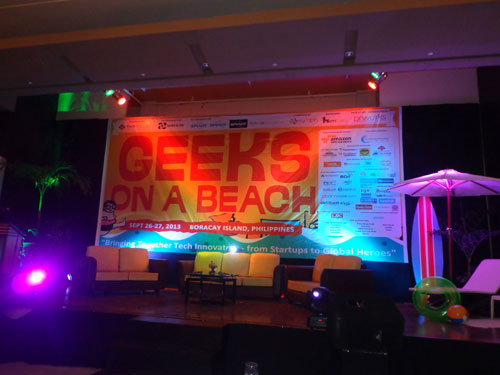We’re at the Pinnacle Hotel at a workshop entitled “Designing Disaster Resilient Communities: Bridging the Hazards Management – Climate Change Adaptation Divide” by Resource Speaker Dr. Gavin Smith.
Dr. Smith is from the University of North Carolina at Chapel Hill. He is Executive Director of the Center for the Study of Natural Hazards and Disasters in the Department of City and Regional Planning in UNC.
The talk is a joint project between the US Embassy and the Philippine Institute of Environmental Planners (PIEP).
Davao Bloggers is covering the event. Our team today is composed of:
- Ria Jose
- Dulce Lada
- Brendel Balaga
- Lyle Santos
- Leah Valle
- Niko Buluan
- Koii Canarias
We’re also online at Twitter at our DavaoBloggers account with the hastag #climatechange.
9 am Start of the Program
9:10 am Ms. Mayu Muñariz, Director of the PIEP on the importance of Environmental Planning and how the workshop was conceptualized.
9:17 am Opening Remarks by Joseph Tordella, Assistant Cultural Affairs Officer of the US Embassy, Manila. Workshop aims to incorporate lessons from the Ondoy disaster and in “recognition that we live in a fragile world.”
9:20 am Dr. Smith takes the podium. “Is there an opportunity to change things?” Will talk about how land use planning can play a role in hazards mitigation in relation to climate change.
Experiences from Hurricanes Fran (1996) and Floyd (1999)
Risk reduction and disaster recovery was not very difficult because of the availability of federal dollars.
Hurricane Katrina in NC: worked with Governor’s Office of Recovery and Renewal.
Center’s Vision:
- Expand our understanding of hazard science through rigorous interdisciplinary research agenda focuse on hazard resilience
- Develop a translational model that moves knowledge into practice using IT products, education, extension and training methods reflecting and diversity and needs of targeted audiences
- Diversify center support, utilizing leveraging opportunities fostered through new and expanded partnerships.
Natural Hazards vs Disasters: “Disasters are a human construct.”
Hazards by itself are not bad. Floods are not bad in itself.
Emergency Management and Hazards Management
4 Phases of Emergency Mgt: Preparedness, Response, Hazard Mitigation, and Recovery
Hazards Mgt: Risk Reduction; what is it you can do to decrease vulnerability; includes land use planning
“US is starting to realize climate change is actually happening.”
With climate change, we don’t if a hundred year event will happen every five years or every ten years, etc.
In 1900, a storm devastated Galveston, Texas. They chose to elevate the entire island and built a seawall. By building a sea wall or levee stopped the natural processes and now there is no beach. The beach which serves as a natural protection is now gone. And the island is now spending dollars to re-create the beach.
Importance of assessing “social vulnerability.”
Some communities in US don’t take capability assessment seriously.
Dimensions of capability are fiscal (internal and external), technical, administrative, and political. Do these have positive and negative effects on your programs?
“It takes political will to say enough.” It’s very hard to have the will to limit development.
10:20 am Robert “Bobby” Alabado, from the City Planning Office, is asking questions regarding limiting and managing development in Davao City.
11:00 am Over 600 million dollars were spent in hazard mitigation funding after Hurricanes Fran and Floyd.
Inevitability of relocation due to sea level rise.
Risk, Sustainability and Disaster Resilience:
- Can high-risk communities be sustainable and resilient?
- Market Behavior vs Risk-Based Planning and Design
- Decreasing Social Vulnerability vs Diverse Popularions
- Linking Planning to Sustainable Development, Hazard Resilience, and Adaptation
“The Filipino family and individual are very resilient but our communities are not.”
12 nn Group Discussions: Talking Points
- How has the Philippines sought to address the differeing vulnerability, capability, and development patterns found in urban, suburban and rural communities?
- What approaches have proven the most successful?
- Can lessons be transferred from urban to rural communities and vice versa? If so, what are the lessons? What are the best ways to share this information?
Reactor: How do we address the housing of indigenous settlers?
Alobado: One of the first settlers in Louisiana were indigenous Filipinos who were brought to educate Louisiana settlers on housing on stilts and other housing adaptations for watery terrains.
Alobado emphasizes the difference in the housing of the urban poor and how easy it is for them to recover from hazards compared to those in the middle classes.
1:25 Disaster Recovery Planning
- Pre-disaster: planning tools, including hazard mitigation
- Post-disaster: long-term recovery and reconstruction
- Importance of planning process: public participation, policy dialogue, facilitation, negotiated rule-making
Lessons from the US: Planning for post-disaster recovery and reconstruction
- Develop pre-event plans for post-disaster recovery
- Disaster recovery plans created after an event can succees under the right conditions
- Invest the time necessary to huild a diverse coalition of support for disaster recovery planning
- Emphasize local capacity building as part of a disaster recovery plan
- Incorporate land use planners and land use planning principles into recovery plans
- Recognize and embrace technical, political and collaborative leadership
- Establish and regularly update the recovery plan fact base
- Incorporate hazard mitigation practices into recovery plans
- Institutionalize sustainable development and disaster resilience through planning for post-disaster recovery
Disaster Recovery Assistance Network
- Public Sector
- International Aid Organizations
- Nations
- Private Sector
- Private Non-profits
- Quasi-Governmental Organizations
- Emergent Groups and Individuals
An organization may do something well-meaning but it might run counter to another organization’s actions. Collaboration is key.
National Policry
RA 10121 The Philippine Disaster Risk Reduction and Management Act
RA 9729 Climate Change Act of 2009
Role of the Land Use Planner
- Improved Use of Existing Planning Tools and Processes
- Land Use Planning Tools
- Planning Process – Disasters as Conflict/Altruism
- Connectivity to Framework – Changing the Defining Characteristics
2:46 pm End of Talk, Open Forum / Q & A




2 Comments
Thanks for this post. This is a great opportunity for bloggers such as us, to help out our respective communities in times of disaster and mishaps. A warm salute to the organizers.
Hi Davao bloggers. I hope I can be part of your community.